Archaeologists working on a site in Aswan, Egypt, have found rock carvings depicting several ancient Egyptian pharaohs, alongside hieroglyphic inscriptions.
Carvings depicting Pharaoh found at Aswan
The team of French and Egyptian archaeologists were on a diving expedition in the Nile river when they discovered the carvings underwater south of Aswan in an area which was flooded when the Aswan High Dam was constructed between 1960 and 1970. Before the flooding, there was a conscientious effort led by UNESCO to record and transfer as many archaeological remains as possible from the region.
But lots of the artifacts were not able to be relocated in time and were soon taken under by the construction project.
Aswan was a significant place for the ancient Egyptians due to its position near the country’s southern border. A number of temples are located nearby, including Abu Simbel, a site featuring four enormous statues of Ramesses II, each being around 69 feet tall.
The site is also home to the Philae temple complex, where the last ever Egyptian hieroglyphic inscription was written in 394 AD.
The archaeology team wants to identify and record surviving inscriptions and carvings that are now submerged in Aswan, such as the pharaoh carvings, according to a translated statement from the Egyptian Ministry of Tourism and Antiquities.
To achieve this, the team are diving to find the remains, and then recording them with photography, video and photogrammetry, a method that involves taking lots of photos of an object that can later be used to create a digital 3D model of it.
The newly discovered inscriptions of pharaohs include those of Amenhotep III (reigned circa 1390 to 1352 BC), Thutmose IV (reigned circa 1400 to 1390 BC), Psamtik II (reigned circa 595 to 589 BC) and Apries (reigned circa 589 to 570 BC). These rulers are all from dynasties 18 and 26, ministry officials wrote in a statement.
Alejandro Jiménez-Serrano, an archaeologist who leads excavations at a necropolis near Aswan and is a professor of Egyptology and Near Eastern Archaeology at the University of Jaen in Spain, told Live Science that Aswan was an important quarry site for granite and it is possible that the newly found remains were intended for transport to another part of Egypt. Or, they could have been part of temples near Aswan.
William Carruthers, a lecturer in the School of Philosophical, Historical and Interdisciplinary Studies at the University of Essex in the U.K., said the finds show that more remains survived the flooding than UNESCO thought was possible when the organization carried out the salvage campaign in the 1960s and 1970s, as per Live Science.
Aswan was also an important military station and for its position on a trade route. Under every dynasty it was a garrison town; and here tolls and customs were levied on all boats passing southwards and northwards.



